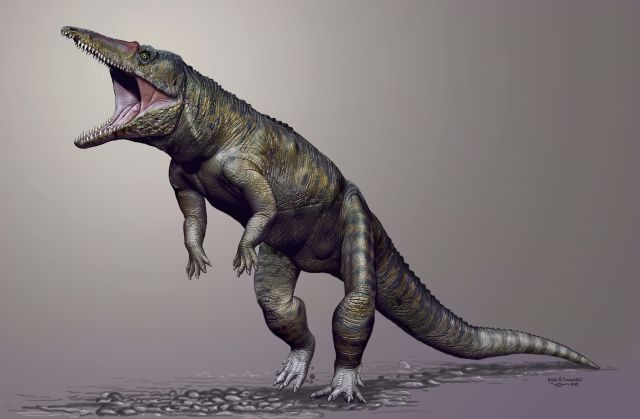
Scientists have just discovered fossils of a 3-meter long, and about 1.5-meter tall land-living crocodile’s skull, spine and upper forelimb. The crocodile, called Carnufex carolinensis or the Carolina butcher, dominated the planet much before dinosaurs came into being. One of North America’s top predators lived in what is now North Carolina 231 million years ago.
Carolina butcher prowled around on two legs, had blade-like teeth and a long skull. It lived alongside animals like aetosaurs, armor plated plant eating reptiles and early mammals, and four-legged phytosaurs, which lived in water and had long snouts. Absence of dinosaurs may have allowed it to grow to its giant size.
The fragmented fossils were discovered by the Paleontologists from North Carolina State University and the North Carolina Museum of Natural Sciences in North Carolina’s Pekin Formation, when North Carolina was a wet, warm equatorial region starting to break apart from the supercontinent Pangea.
“Fossils from this time period are extremely important to scientists because they record the earliest appearance of crocodylomorphs and theropod dinosaurs, two groups that first evolved in the Triassic period, yet managed to survive to the present day in the form of crocodiles and birds. The discovery of Carnufex one of the world’s earliest and largest crocodylomorphs, adds new information to the push and pull of top terrestrial predators across Pangea,” lead study author Lindsay Zanno from North Carolina State University, said.
“Abject terror,” said Zanno; “Climb up the nearest tree,” advised, Vince Schneider from North Carolina Museum of Natural Sciences.
“As one of the earliest and oldest crocodylomorphs, Carnufex was a far cry from living crocodiles. It was an agile, terrestrial predator that hunted on land,” Zanno said adding, “Carnufex predates the group that living crocodiles belong to”.
Typical predators roaming Pangea included large-bodied rauisuchids and poposauroids, fearsome cousins of ancient crocodiles that went extinct in the Triassic Period. “In the Southern Hemisphere, these animals hunted alongside the earliest theropod dinosaurs, creating a predator pile-up,” she added.
The discovery of Carolina butcher, however, indicates that large-bodied crocodylomorphs, and not dinosaurs, were adding to the diversity of top predator niches.
“We knew that there were too many top performers on the proverbial stage in the Late Triassic. Yet, until we deciphered the story behind Carnufex, it wasn’t clear that early crocodile ancestors were among those vying for top predator roles prior to the reign of dinosaurs in North America. Theropods were ready understudies for vacant top predator niches when large-bodied crocs and their relatives bowed out. Predatory dinosaurs went on to fill these roles exclusively for the next 135 million years,” she explained.
“As theropod dinosaurs started to make it big, the ancestors of modern crocs initially took on a role similar to foxes or jackals, with small, sleek bodies and long limbs. If you want to picture these animals, just think of a modern-day fox, but with alligator skin instead of fur,” Susan Drymala co-author of the study and graduate student at North Caroline State University, said.






